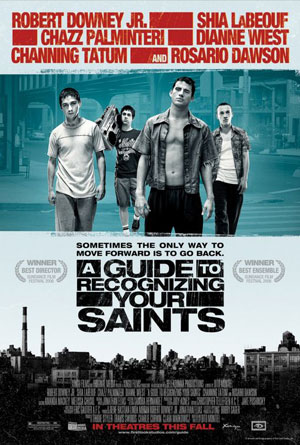 The New York City I grew up in is gone. The streets are still there, and most of the buildings, but there’s something fundamentally changed. And there’s something fundamentally changed in me, too. New York City isn’t the same in 2006 as it was in 1986, and neither is Devin Faraci.
The New York City I grew up in is gone. The streets are still there, and most of the buildings, but there’s something fundamentally changed. And there’s something fundamentally changed in me, too. New York City isn’t the same in 2006 as it was in 1986, and neither is Devin Faraci.
A Guide to Recognizing Your Saints is about that. It’s about growing up in New York City in 1986 and coming back to it twenty years later and seeing the changes in the town and in the boy who became the man. That boy is Dito, running in the streets of Astoria, Queens. That man is Dito, a writer living in Los Angeles. The film is about the summer where one became the other.
Based on the book of the same name, A Guide to Recognizing Your Saints is written by the real Dito Montiel. While it’s easy to assume that it’s just self-indulgent nonsense, Montiel hasn’t created an overinflated fantasy world out of his past – the life of young Dito isn’t tragically difficult or poetically troubled. He’s basically a good kid who likes to hang out with his friends and get fucked up. There’s tragedy – Dito’s friends make terrible choices that ruin or end their lives – but it feels real. I knew kids like that. I knew kids who made those choices. I knew kids who didn’t make it out of the 80s.
As a first time director, Montiel makes some interesting – and occasionally bad and over-stylized – choices, but where he’s right most of the time is his casting. A Guide to Recognizing Your Saints has a phenomenal group of actors in it, both in the scenes set today, where Robert Downey Jr is Dito coming home, and in 1986. Unfortunately the film’s real lead, Shia LaBeouf, is the only serious casting misstep – he doesn’t feel like he belongs in the neighborhood, and he’s often too self-consciously acting, being the trained young Hollywood performer that he is. Thankfully he’s surrounded with other young actors who bring a completely authentic feeling to their roles, including Tatum Channing as the troubled Antonio.
Antonio is the leader of the little gang Dito runs with, and his dad (a fantastic Chazz Palminteri) loves the big, tough kid almost as much as he loves his own son. The group wander the streets, doing whippets and sneaking into the community pool after hours and trying to get with the pretty young girls on the block. Dito and Laurie are an item, but in that chaste middle school way. Melonie Diaz plays young Laurie and Rosario Dawson the older Laurie – it’s a testament to the younger girl that she matches Diaz in beauty and outpaces her in acting.
You can’t shoot a movie in New York today and make it look like New York of 20 years ago. The changes are subtle, but for a knowing audience, obvious. Montiel does a fairly good job of recreating 1986 on a budget, but the fact that the 21st century still shines through only underscores the film’s sense of loss – the world that Dito knew, and the people in it, are gone forever. You can’t even make pretend like it’s there.
In a lot of ways A Guide to Recognizing Your Saints is a movie that’s almost genetically engineered to work for me. The exact details of Dito’s life are different, but the story’s still one I know. But if I felt the film worked only as a nostalgia trip for a certain generation of New Yorkers I couldn’t recommend it. I can recommend it because Montiel has created a trulypowerful, moving and insightful look at the confusing cusp of adulthood and the scars it leaves you with.